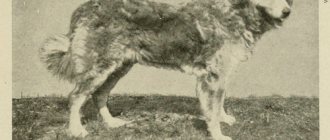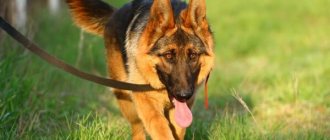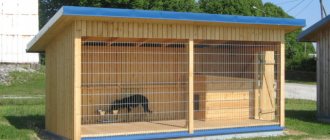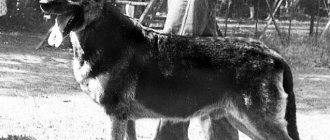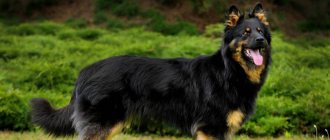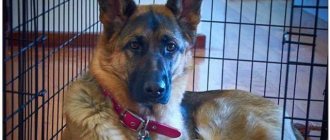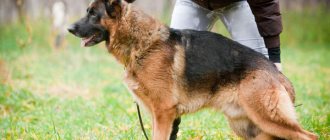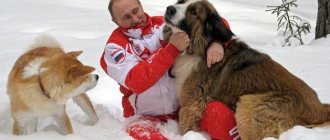History of the East European Shepherd breed
Like most domestic service breeds, East European Shepherds were bred in the 30-50s of the 20th century, due to state necessity.
By the way, the expression “state necessity” meant guard and escort service in the Gulag, which for obvious reasons was not advertised. The breeding material for creating the next superdog was German shepherds, thanks to which several breed lines were formed in the USSR. In particular, the most sought-after offspring were those from imported males such as Edu von Heisenhof, Edie von Blumenduft and Devete von Furstensteg. After the Great Patriotic War, the VEO population in Soviet nurseries was reduced to a critical minimum, which is why work on the development and improvement of the breed had to start from scratch. However, already in the 60s, seven new breeding lines appeared in the country, the representatives of which demonstrated outstanding service and exterior qualities. The era of Stalinist camps and prisons had by that time become part of history, so animals began to be recruited for service in the Ministry of Internal Affairs, and also used as guide dogs. Domestic cinema also fueled interest in the breed. After the release of the films “Come to me, Mukhtar!” and “Border Dog Scarlet” almost every second Soviet schoolchild dreamed of acquiring an East European Shepherd.
In 1964, the first full-fledged appearance standard was drawn up for the “Easterns,” which provided them with recognition first by the Union of Cynological Organizations of Russia, and later by the RKF. As for similar foreign and international communities, not all of them agreed to consider VEO as a separate breed. For example, FCI still positions East European Shepherds as the Russian branch of German Shepherds: updated and improved, but generally retaining the phenotype and psychological traits of their ancestor.
The emergence of the East European Shepherd breed
The East European Shepherd, or East European Shepherd, was practically the only service dog breed bred in the USSR. When the First World War took place, everything connected with the Germans was secretly prohibited. For example, the capital of the empire was renamed from St. Petersburg to Petrograd. German Shepherds also began to be called Central European. By that time, cynologists of the USSR had already begun their work on breeding the Russian line of these dogs, which differed from the original sources. They took the German Shepherd as a basis and infused it with the blood of Central Asians, Laikas and Malossians.
The use of dogs to protect the borders of the Soviet state began on May 25, 1894. On this day, a circular was signed, which stated that when protecting the state border, for greater efficiency, specially trained dogs can be used. This was the first official document in Russia that attributed the use of canines to public service.
In terms of use, the East European Shepherd is no different from the German one. She is involved in search and surveillance services. The main dog of the workers' and peasants' Red Army was a line of domestically bred German shepherds. Later, the name East European Shepherd will be assigned to it. Despite the fact that these dogs were often used as guard dogs, most people associate them more with “Mukhtar” or the dog “Alym” - heroes from Soviet films.
The popularity of the East European Shepherd was absolutely justified, because the dogs had a much nicer disposition and obedience than the German Shepherd. They are suitable for service in any terrain. Therefore, he lives quietly on the street at temperatures of minus forty and plus thirty. These shepherds can go without food or water for a long time. They are versatile for service and as companions for families and children. German Shepherds are more playful and require constant movement and attention. With the “Eastern” it is simpler, the dog always agrees with the owner’s opinion and obeys him.
In the middle of the last century, the future of East European Shepherds was promising and quite stable. But, at some time, unfortunate breeders decided to abandon the breed. And, after all, this was the pride of domestic cynology. The motivation for this behavior was that the East European Shepherd was not recognized by the International Canine Association.
Despite all the forecasts of skeptics, the breed has survived, but the number of its livestock has decreased significantly. In the nineties, our Iron Curtain collapsed, and new breeds began to be brought from abroad, which gradually supplanted the “easterners”. The revival of this variety began in 1991. Then, in Moscow, they created an association of breed nurseries for East European Shepherds. Now the breed is recognized by the Russian Cynological Federation, but, unfortunately, it is not yet recognized by the International Cynological Federation.
Breed standard of the East European Shepherd and differences from the German
Considering that the purebred VEO is, in fact, a “Russified” German shepherd, one cannot count on cardinal external differences between the breeds. Nevertheless, if you put an exemplary “German” and his Soviet descendant side by side, it is quite possible to identify each. Usually the first thing that catches your eye is the impressive build of the “Eastern”. As an example: the average male German Shepherd has the same height and weight as an Eastern European female, and this despite the fact that both breeds are characterized by sexual dimorphism. According to the breed standard, the height of the East European Shepherd at the withers is 66-76 cm for males, 62-72 cm for females. The weight of “boys” and “girls” is 35-60 kg and 30-50 kg, respectively.
An important nuance is the line of the back. For the “Germans” it is strongly sloping (the angle of inclination is about 23°), while for the “Easterns” the top looks almost horizontal. VEO's legs are much thicker and more massive than those of his ancestor. Hence the differences in movement. German Shepherds move at a short, shooting trot with a long stride, while Eastern European dogs move at a more sweeping and heavy pace.
Head
The skull is flattened, widened between the ears, with a shallow longitudinal groove. The brow and occipital protuberance are weakly marked. The stop is moderate, without harshness. The muzzle of the East European Shepherd is wedge-shaped, narrowed in the area of the lobe, but not pointed.
Jaws and teeth
The jaws of the East European Shepherd are powerful, with a full set of 42 large teeth. The only type of bite allowed by the standard is “scissors”.
Nose
The bridge of the nose is smooth, the lobe is massive, coal-black.
Eyes
The eyes of the East European Shepherd are medium in size, regular oval in shape, set slightly obliquely and very wide. The desired color of the iris is as dark as possible.
Ears
Medium in size, erect, with a triangular ear shape and a rounded tip. The ears are set wide and above eye level; in a calm dog they can take a slightly hanging position, in an alert dog they are raised strictly vertically.
Neck
Set to the back at an angle of 40° to 45°, gradually widening towards the shoulders. In purebred individuals, the necks should be muscular, without dewlap.
Frame
The body of the East European Shepherd is balanced, rectangular and moderately stretched. The back is strong, almost straight, elongated. The loin is slightly convex, short and massive. Well drawn: the line of the withers and the wide rounded croup. The chest of representatives of this breed is oval, reaching to the elbows, with neatly curved ribs. The belly is moderately tucked.
Limbs
VEO has straight, parallel legs, with the hind legs noticeably drawn back. The shoulder blades and humerus are elongated and obliquely located. The angle of the glenohumeral joint is approximately 100°. The animal's forearms are straight, turning into elbows tightly pressed to the sides and long springy pasterns, standing at a slight angle.
The hind limbs look more massive due to the muscular thighs. The dog's shins are moderately long, but not excessively elongated, the metatarsals are strong, almost vertical. The Easterners' paws have a classic oval shape with balled paws and dense black pads.
Tail
Descending to the hocks or below, saber-curved. A calm dog's tail is lowered down, while an excited dog's tail is raised (by about ⅔) to the top line of the back.
Wool
The coat of East European Shepherds is double, formed by a dense soft undercoat, which has a lighter tone, and a hard, semi-long coat, which is darker in color. Areas with abundant long hair are the neck and hips; with the shortest possible length – the head, the front of the legs, the surface of the paws and fingers.
Color
East European Shepherds can be black and tan, black or black and gray. The following colors are also allowed by the standard: black with lightened areas (marks above the eyes, on the paws, cheekbones, under the tail), black and tan and zoned gray. Not welcome, but zonular red color is also possible.
Disqualifying faults
- Floppy ears.
- Various bite deviations, including a skewed jaw.
- Incomplete dental formula.
- A suit that goes beyond the standard.
- Insufficiently pigmented lobe.
- Wool devoid of undercoat.
- Too short tail.
- Albinism.
- The presence of a cataract, heterochromia or blue iris.
- Curly, excessively long or short hair.
- A weaving, rolling gait.
- Cryptorchidism.
- Unreasonable anger and cowardice.
Character of the East European Shepherd
The average “Eastern” is more phlegmatic and reasonable than his German relative. He is not harsh or quick-tempered, which in case of danger does not prevent the animal from making a decision and acting with lightning speed. Well, to be more precise, the East European Shepherd is a dog that does not like the aimless manifestation of any qualities. The whole being of this serious, tireless servant strives to be useful to the owner. Accordingly, if you do not need either a vigilant watchman or a prudent security guard, finding an alternative type of activity for the VEO will not be easy.
East European Shepherds do not favor strangers, and this hostility is ineradicable. At the same time, the dog will not rush at a stranger as soon as he appears in sight. Yes, the animal is ready to protect its owner 24 hours a day, but only when the threat is really real. However, clarification is necessary here: well-trained individuals behave so restrainedly, the owner of which was not too lazy to go through the OKD with them. With young dogs that have not learned to manage their own emotions, it is better to keep your finger on the pulse. These “comrades” are not yet able to distinguish between a friendly pat on the shoulder and a full blow, and noisy companies from gangs of hooligans, so they can turn on the defender mode at the most inopportune moment.
Another pleasant bonus for fans of East European Shepherds is that male dogs do not have the habit of competing with their owner for the status of alpha male. With proper upbringing, the breed willingly hands over the reins to humans, easily getting used to the status of a companion and observing the necessary subordination. The only thing is that you will have to assign roles in the house immediately after the puppy appears in it. If this is not done in a timely manner, the East European Shepherd will have reason to suspect the owner of lack of character. And this is a direct path to disobedience, stubbornness and, ultimately, to a dangerous confrontation between owner and pet.
In general, East European Shepherds have a temperate character, as evidenced by their good-natured attitude towards children. The dog also does not harm the pets with whom she had to grow up. But VEO can get angry with stray cats and dogs, so on walks it is better to take your pet’s interest in other four-legged creatures under personal control.
Education and training
In terms of learning, East European Shepherds are solid good students. They are smart, willingly delve into the essence of the actions explained to them and do not confuse reality with the situations simulated by the dog handler on the training ground. VEOs easily deal with basic OKD commands and learn the basics of ZKS with no less enthusiasm, but this is not the breed that masters the material once and for all. As dog handlers like to say: the East European Shepherd learns and trains throughout its life. This is the only way to really control the animal and not have to fear for the safety of others. Accordingly, when introducing such a brutal pet into your home, you need to be prepared for the fact that training and repetition of the material covered will become an integral part of your life.
Important: the East European Shepherd considers its owner not the one who brings him a bowl of food every day, but the person who trains it, so it is better to train the pet on your own, consulting a professional dog handler only in the most difficult situations.
Up to two months, an East European Shepherd puppy is socialized, that is, the dog must get used to its place of residence, owners, sounds and smells that accompany it at home. From the age of two months, learning of elementary commands and obedience lessons begins, which will at the same time prepare for the upcoming OKD. At this age, the baby will have to learn a new rule: before performing an action, it is necessary to obtain the owner’s permission. By the way, it is possible to fully train a shepherd dog only if it understands and recognizes the authority of the owner. When playing with your VEO puppy, do not let him win. The baby regards this behavior as a weakness that he will not hesitate to take advantage of.
The age of 4 months is the optimal period for learning more complex commands from the same OKD with the East European Shepherd. If everything is planned correctly, by 6 months the puppy will be ready to pass the course standards and will be able to begin engaging in security activities. True, up to a year, the skills and abilities acquired by the pet will have to be further honed and brought to perfection. As noted earlier, repetition of material for the breed is an urgent need.
For owners planning a sports career for their pets, we can recommend the international IPO course. However, it is worth understanding that such programs from the impressive and, what’s more, heavy “Easterners” go through with difficulty. As for the ZKS, it makes sense to enroll an East European Shepherd in such courses after it has successfully completed the OKD, and also if you are a law enforcement officer and work in tandem with a four-legged friend. In other cases, completing such a rigorous program is not necessary. If necessary, the East European Shepherd will protect its owner even without training, and due to its fairly calm temperament, VEO will not make mince out of an enemy. Her mission is to catch up with the conditional aggressor, put him on his shoulder, demonstrating his own physical superiority. However, in 90% of cases, it does not come to a full-fledged race after the enemy: having assessed the dimensions of the East European Shepherd, attackers prefer to disappear from the sight of such a vigilant bodyguard.
Purpose and character of the East European Shepherd
East European Shepherds have proven themselves to be excellent service dogs. They were specially bred for police and military service. Many years of selection work have led to the appearance of a brave, devoted dog, which is still used to this day for guard duty. In addition, representatives of this breed can be wonderful companions and even rescuers. They are full of inner confidence and dignity, thanks to which they become not only excellent bodyguards, but also full members of the family. The main feature of this dog is its owner-oriented nature. At any moment she is ready to give her life for him. She does not trust those around her, but, thanks to her strong nerves and balanced psyche, she treats them calmly and does not show aggression unless necessary. If a dangerous situation arises, the dog instantly takes an active defensive position.
The breed is easy to train and demonstrates obedience and willingness to obey its owner. She rarely shows independence. The dog is friendly towards other pets, especially if they grew up together.
East European Shepherds have a good character - they are devoted friends of humans, love children and are ready to play with them at any time. These dogs will never hurt a child, even someone else's. The only condition for the formation of all these positive qualities is proper education from puppyhood.
Maintenance and care
For a typical city apartment, the East European Shepherd is not the most suitable size, so if you have already decided to add to the family, think in advance about how to provide the dog with a sufficient amount of free space. In particular, the pet's bed should be in a secluded but well-lit place - the breed does not need rickets. If the shepherd's mattress lies in the aisle, where the feet of household members are constantly clinging to it, this irritates and unnerves the puppy. It is better to choose a semi-rigid mattress for the East European Shepherd to avoid the appearance of calluses on the elbows, and fix the food bowl on an adjustable tripod (choose the highest design), which will reduce the load on the joints.
The optimal option from the point of view of convenience for the owner is to keep the East European Shepherd in an enclosure with an insulated kennel, which should be of such a size that the dog can not only lie down in it, but also stretch out its paws. Dry hay is suitable as bedding. The main thing is to remember to change the bedding in a timely manner and treat the dog’s home for parasites twice a year. Usually, a signal that it’s time to disinfect is the shepherd’s reluctance to lie in the kennel. In the summer, VEO’s hay “bed” is not needed, but to prevent your pet from developing elbow calluses, it is better to lay a rug in the enclosure. And most importantly: no chains, even if they are long and allow the dog to run all over the yard. This approach spoils the animal, developing in it distrust of the owner and anger against the whole world.
Hygiene
To make your life easier in the future, teach your puppy the idea of hygiene as a necessity that is inevitable. Remember, an East European Shepherd is not a Pomeranian that can be immobilized with one hand. And if a pet resists hygiene procedures from an early age, then when the animal matures and gains muscle mass, it will be impossible to “persuad” it. Otherwise, the breed is considered unpretentious and does not require professional care. For example, daily brushing of VEO will be required twice a year, during the shedding season. In the intervals between these periods, dead hairs are removed once or twice a week with a brush or rubber mitten. It is recommended to wash your East European Shepherd twice a month if the animal does not run through puddles. In summer, you can limit yourself to swimming in open water, which the breed absolutely loves.
It is better to examine your dog’s ears regularly, but there is no point in fighting for complete “sterility” of the ear canal. Remove brown plaque with wipes and veterinary lotions only when there is really a lot of it accumulated. Remember, frequent “diving” of cotton swabs into the ear funnel provokes sulfur secretion, which makes the ear look even more untidy. By the way, it is better not to pet East European Shepherds on the head until they are one year old. The breed’s ear tissue is heavy, slow and difficult to “stand up”, so any careless touch to it can cause incorrect placement of the cartilage.
Walking and physical activity
East European Shepherds are active and strong dogs, although they are inferior to their German relatives in endurance. Accordingly, they should be less stressed during training and walks than German shepherds. For example, until the age of 7-8 months, a VEO puppy is prohibited from any physical activity. The only thing your baby can count on is short excursions in the park and swimming in rivers and lakes if the weather is warm enough. Puppies are also not allowed any harnesses with weights, although such accessories are not prohibited and can be a good help in training a service dog.
Traditional walks on a leash are not practiced with adults. If a mature “Eastern” has already gone out into the street, he should be allowed to let off steam. Typically, the breed needs 1-2 hours to warm up, which can include towing objects in the snow or sand, racing behind a bicycle, jogging in shallow water and swimming. But all this is provided that the pet is healthy. For sick and cold dogs, any sports, including water sports, are strictly contraindicated. In addition, in the first year of life, it is better not to offer jumping exercises to your East European Shepherd. Like any large breed, such exercises are difficult for VEO, which only accelerates wear and tear on the joints.
Feeding
The East European Shepherd does not require a specific diet. She will be satisfied with a traditional dog menu or premium industrial food. However, it is better to follow a number of simple rules to keep your pet healthy.
- Meat is given raw if it is fresh and you are aware of its origin. In other cases, it is better not to risk it and boil or scald the product.
- No food from your table, even if the pet asks.
- Less fruits and vegetables in your diet. Yes, they contain a lot of vitamins and healthy fiber, but the digestive system of the East European Shepherd is poorly suited for digesting plant foods.
- Dogs do not need any “tasting” additives. In particular, porridge from several types of cereals, nuts and dried fruits are unnecessary excesses that are not worth spending time and money on.
It is almost impossible to properly balance the natural diet of an East European Shepherd at home, so all kinds of supplements and veterinary dietary supplements come to the rescue. For example, VEO puppies are given complexes with chondroitin and glucosamine to support articular cartilage. However, here too it is important not to overdo it: an overdose of minerals and vitamins is a serious thing. First consult with a specialist who will accurately determine whether your ward needs additional feeding or can easily do without it.
Usually puppies move to new owners no earlier than two months of age. This is exactly the period when the baby is transferred to five feedings a day. From 4 to 8 months of life, the East European Shepherd eats four times a day, from 8 months to a year - three times. It is recommended to switch the “Eastern” to two meals a day from the age of one and a half years, but even such individuals are given a light kefir or fruit and vegetable snack in the middle of the day for the first 5-7 months.
Features of care
Combing
The East European Shepherd breed is easy to care for and does not require grooming. All she needs is enough walks, regular visits to the vet and hygiene. It is worth washing your dog 1-2 times a year if necessary. In the summer, it is worth taking your pet to a pond where he can swim, this will be useful for the ligaments. It is worth brushing your pet several times a week, and during shedding - every day, using a furminator. It is also important to check your teeth regularly, give your dog special food that he can chew, and clean his ears every 2 weeks.
Walk
The East European Shepherd will need frequent walks from an early age. This breed, like the Greyhound, loves to spend time with its owners, run and play a lot, and get to know the world. If you are planning to get an East European Shepherd, then expect that you will need to walk it often and for long periods of time. If you do not give vent to the breed's activity, you may get aggression or disobedience in response during training.
Health and Diseases of East European Shepherds
East European Shepherds have good health, but the breed’s predisposition to a number of diseases has not been canceled. For example, VEOs are susceptible to gastric volvulus, which is why feeding them large portions is strictly contraindicated. In addition, like the vast majority of large dogs, the joints of the “Easterns” often make themselves felt. Moreover, this can be either classic dysplasia, caused by excess weight and physical inactivity, or inflammatory diseases such as arthritis. Shepherd dogs also inherited glaucoma and entropion from their ancestors, which is why it is so important to study the pedigrees and veterinary passports of litter producers.
Prices for puppies
East European Shepherd puppies with RKF documents cost from 15 thousand rubles and above . Much depends on the presence of eminent ancestors in the pedigrees, awards at exhibitions, and the service achievements of the parents. More affordable prices: from 3,000 rubles and above indicate that the puppy’s parents do not have a pedigree. In this case, there is also a chance to buy a good dog with all the typical characteristics of the breed, but this is already a risk, since you can buy a mixed breed or not a VEO, but a German shepherd. Therefore, if the choice of an “Eastern” is important for you, then it is better to spend more money, but get guarantees of the thoroughbred of your friend.
Video
How to choose a puppy
- Meet the puppies' mother and evaluate her temperament as it is passed on to her offspring. In particular, if the breeder puts the bitch on a leash before you arrive, she is most likely aggressive and difficult to control. Think about it, do you need a puppy with such hereditary baggage?
- An East European Shepherd barking at a stranger is common, especially if it is a female protecting her offspring. However, the litter producer should not take more drastic actions.
- When choosing a future service dog, focus on the working qualities of its parents. Do you have diplomas in ZKS and OKD? Great! In 9 cases out of 10, the puppy will repeat, or even break, the parent’s records.
- If you take an East European Shepherd as a pet and companion, resist the temptation to grab the most playful little one with leadership inclinations. In addition, check with the breeder how the mother of the puppies treats children. The breed's love of children is also hereditary.
- If you are afraid that you will not be able to cope with raising and training an East European Shepherd, refuse to buy pre-grown puppies. On the one hand, it is great that the breeder managed to do some of the work by socializing the teenager, giving him the necessary vaccinations and teaching him commands, but it is more difficult to retrain such a puppy and adapt it to personal preferences.
- When buying an East European Shepherd for breeding, look online for information about the nursery’s participation in exhibitions, and also find out whether its students have won any awards.
East European Shepherd puppies
East European Shepherd puppies are very different from adult dogs of this breed. Their ears are still soft, their faces are round, and only a competent breeder is able to make any assumptions about their working and breeding future. All future owners have a good idea of what they dream of seeing their adult dog. Few of them dream of a frail creature on thin legs, vaguely reminiscent of one or several breeds at once, and huddling in horror in a booth when strangers come into the yard. Therefore, it seems very strange that people are able to buy puppies for themselves “just to be cheaper.” Those 10-15 years that you spend next to your dog can become a happy time of life for the owner or turn into a bad dream. It depends on what kind of puppy you choose.
There are several guidelines that will help when choosing a puppy:
- Do not be intimidated by the breeder’s detailed questions and his doubts about your worth as an owner. Such breeders are the best friends of their owners and will help with useful advice at any time.
- The presence of documents for your dog is a guarantee of its purebred behavior and pedigree behavior. No matter what the market tells you when selling a puppy that looks like a shepherd, purebred breeding involves strict rules and selection. A puppy with documents has parents who have not only a pedigree, but also a show grade, and have also passed a mental health test. This is the systematic work of a nursery that selects all the best dogs for breeding, taking into account their origin, health, working qualities and exterior.
- If you want a working dog, don't get a puppy with poor pigmentation or white spots. In general, the best service dogs among VEOs are dogs with zonal coloring. Ask the breeder to show you the work of the mother bitch, choose the most confident puppy, and do the Campbell test with the kids.
- If you dream of a family dog, feel free to take the puppy who came to you first to meet you. Puppies sitting sullenly on the sidelines may be unhealthy, distrustful of people, or simply waiting for other owners.
BEFORE your puppy arrives, secure the place where he will live. Fill holes, cover the basement and cellar, cover the inspection hole in the garage, remove wires and hanging hoses. Let your puppy out into the yard under supervision for the first few days to identify any weaknesses in your preparations and address them. Do not neglect preventive vaccinations and control of fleas, ticks and helminths. Give the puppy the opportunity to move freely in the apartment or house - this will allow him to properly form joints and holidays.
